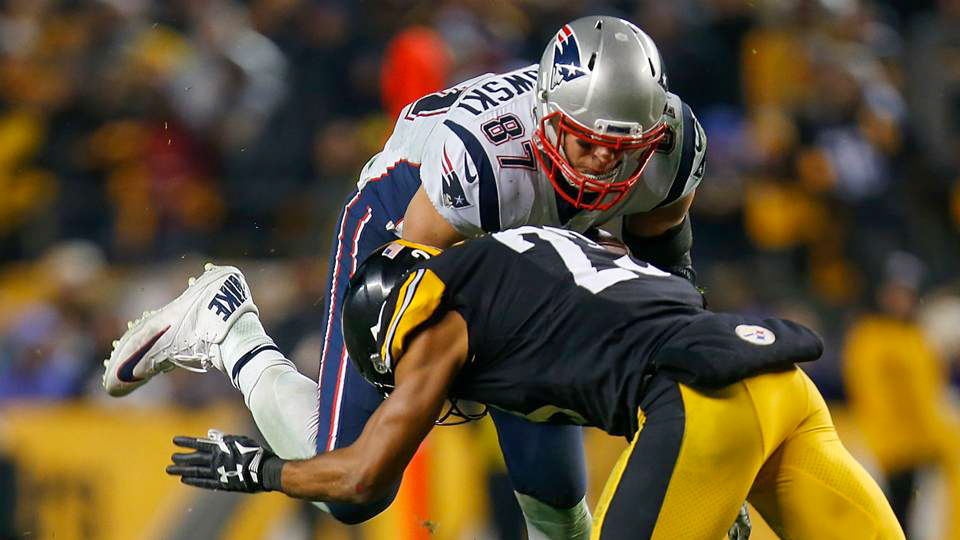
c/o sportingnews.com
Nothing feels more American than relaxing on a sunny Sunday afternoon, grilling up some hamburgers with family, and watching grown men try to disable each other on national television over possession of a leather ball. Sure, it’s a rudimentary description of one of America’s pastimes, but football is intrinsically a violent sport. That is what makes football the most popular sport in America. Like a neo-Coliseum, football attracts viewers hoping to get a taste of aggression in their otherwise unstimulating lives. And like its Roman predecessor, the performances are not without serious health implications.
In recent years, the National Football League has been under fire for the prevalence of concussions and head injuries among players. A Boston University study found Chronic Traumatic Encephalopathy (CTE), a degenerative brain disease caused by repetitive head trauma, in 99 percent of NFL players’ brains. The symptoms of CTE have been known to involve mood swings, depression and memory problems. However, the consequences of CTE were not entirely understood until Aaron Hernandez, a tight end for the New England Patriots at the time, was found guilty of first-degree murder in 2013. Hernandez was sentenced to life in prison and eventually killed himself in his jail cell, which allowed scientists to study the brain of the 27 year old shortly after his death. Researchers at Boston University found that Hernandez “suffered from the most severe case of CTE found in a person of his age”. While it is not the case that everyone who develops a severe case of CTE will become a murderer, it is likely that the disease was at least somewhat to blame for Hernandez’ actions.
NFL fans may have noticed the strong intervention by the league to prevent hard hits and tough tackles. The league added new rules for safety before the start of this season, the most controversial of which disallows the use of the helmet to initiate contact while tackling. Many fans are disappointed with the rule change, believing that the league is “soft” for barring rough tackles. Some players are frustrated as well, feeling as if officials are handcuffing them and making it impossible to play football the way it is meant to be played.
Referees have been looking for rough hits with new, more restrictive rules, resulting in a sharp increase in penalties. Week 1 of this season saw an average of 15.9 accepted penalties per game, an uptick of 19% from last year. Aaron Rodgers, a quarterback for the Green Bay Packers and one of the league’s most popular players, recently criticized the new rules, saying that “many are going in the wrong direction.” Rodgers is not alone in his frustration with the rules, as fans have been turning off games to so something else. NFL viewership has steadily declined over the last few years. The season opener between the Philadelphia Eagles and Atlanta Falcons brought in 19 million viewers, a nine-year low. Much of this may be due to national anthem protests, but rule changes have certainly played a role in the decline of the NFL’s popularity. So, the NFL is at a crossroads. Should it allow players, who are willing to risk injury, to “play the game” freely? Or should it intervene to try to protect the players’ health and well being?
It is absolutely imperative that the NFL continues to create and preserve rules protecting the health of their players. This includes the new rules instituted by the NFL that players are complaining about. Not only is the fear of CTE hurting NFL viewership, it is hurting the future of the game. Youth football participation has decreased nearly 20 percent since 2011. Fear for their kids’ health has prevented many parents from allowing involvement in tackle football. That means that the next Tom Brady or Odell Beckham Jr. might end up playing baseball or soccer instead of football. Do we, as fans, really want to miss out on the opportunity of watching one of these great players because their parents were concerned about the long-term consequences of playing football? No, of course not.
If the NFL pays more attention to its players’ health, it will restore the faith of Americans in the sport. News about CTE and brain trauma has constantly been in the media, bringing lots of negative attention to the NFL and highlighting the consequences of repetitive head trauma. It is now the responsibility of the league to care for the people who make it billions of dollars each year. The emphasis on safety will frustrate players, but that is mostly irrelevant. A defensive end making millions of dollars is not going to stop playing because he can’t hit as hard as he would like. The NFL needs to ignore the complaints of the few and focus on the safety of the many. Eventually, football will become a less violent sport. People will still tailgate games on Sunday afternoons and will still watch with family and enjoy the sport. In the future, the men on the screen will no longer be trying to disable each other. Maybe cause a few sprains.
Nick Keating can be reached at nkeating@wesleyan.edu.
Comments are closed